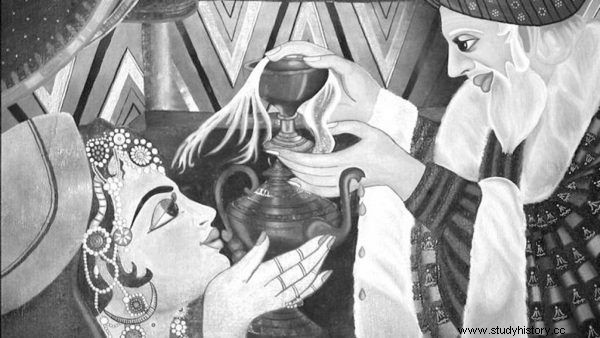People since the dawn of time have not poured out over the collar. And since the dawn of time, they have had to deal with the unpleasant consequences of drinking. How did our ancestors cope with a hangover? Some are better, some are worse. One cannot be denied to them - in terms of finding treatments for the "next day syndrome" they were able to reach the pinnacle of creativity ...
Simply put, it can be said that the history of a hangover is one day younger than that of drunkenness. The first man to wake up in the morning with a headache and nausea after a heavily drenched evening the next day probably did not realize what was happening to him. However, people quickly realized who to blame for their morning indisposition - and began looking for remedies.
Abstinence was hardly an option - our species' taste for alcoholic beverages has a long history. Mark Forsyth emphasizes that archaeological finds suggest that beer appeared before temples and agriculture . As he writes:
On the foundation of these premises lies a great theory of human development:we did not start farming because we wanted food - there was plenty of it. We started farming because we wanted to shave.
So how were the effects of drinking dealt with in the past? Well, some of the ways were really weird… Here is a historic hangover treatment guide. Be warned - you better not try this at home!

Bacchus' triumphal retinue
Just keep drinking!
One of the oldest and most popular methods of treating a hangover (by some people still used today) is "pulling a hair out of the hair of a dog that has bitten you", that is ... driving a wedge. He recommended driving one wine away with another, living in the 4th century BC Antiphanes. Later, this "tradition" was eagerly continued by subsequent generations. Shaughnessy Bishop-Stall concludes:
Even in the 11th century CE medics used the works of Hippocrates, Galen and other ancient physicians, whose works were translated into Latin by the monks and placed in a great medical compendium entitled "Regimen Sanitatis Salernitanum.
This compendium recommends wine and other alcoholic drinks for all ailments - from indigestion to loss of your mind. It also describes exactly what to do if the recommended dose is exceeded:
If you experience a hangover after drinking in the evening, have a drink again in the morning. It is the best medicine.
Well, undoubtedly, this method allows you to get rid of unpleasant ailments temporarily, but in fact it only delays them in time, and in addition it is a straightforward way to alcoholism. That is why people for centuries have tirelessly sought other ways as well. Which ones?
Summon Mother Nature for help
Our ancestors assumed that since nature gave them alcohol, it could also offer an effective hangover remedy. That is why they sought solace in the world of plants and animals. And so the ancient Egyptians saved themselves by wearing necklaces made of butcher's leaf . They believed that this herb was beneficial for headaches. Did it also help with a hangover? It's hard to say.
In Assyria, fauna and flora were put together, and those who had hangovers were served powdered bird's beaks mixed with the fragrant resin of embalm tree . In turn, the ancient Romans used fried canaries and owl eggs (the latter was recommended by Pliny). The fatty food was certainly relieving to some extent.
On the other hand, marinated sheep eyeballs had a dubious effect allegedly enjoyed by Outer Mongolia drunkards, toasted pig lungs served for a hangover in Wales, or rabbit fecal tea (this is how the cowboys in the Wild West tried to save themselves). Raw eels which were served for breakfast after a crazy night, probably also had difficulty passing through the throats of the “patients”. The more so because it was believed then that fish come alive in the stomach ...

The ideas for fighting a hangover were surprising
Strengthen the head with a skull
Equally disgusting was the composition of an apparently innocent drug called "Goddard's drops." In 17th-century England, they were recommended to King Charles II Stuart by his court physician, Dr. Johnatan Goddard. The specificity was made from dried viper, ammonia and ... the skull of a recently hanged convict.
The history of this "strong headache" remedy is longer. As early as 1667, "The London Destiller" advised:
Cranium humanum in the selected amount, crush it finely (...), then apply a stronger and stronger fire to it, until the vapors stop coming out. You will get yellowish spirit, red oil and volatile salt.
The drink obtained with this method had a versatile effect:apart from a hangover, it was prescribed for gout, swelling, weak stomach or epilepsy.
For people with slightly weaker nerves, there was an alternative version - instead of the skull itself, it was proposed to take previously grown and dried moss in it . It's hard to say which was better - inhaling "dead moss", eating a human skull, or chewing a dried bull's penis (this custom was practiced by the Sicilians at the turn of the Middle Ages and the Renaissance).
Don't be afraid to get dirty…
In Victorian England, people were not afraid of dirty work. And since the industrial revolution was triumphant, they had plenty of dirt and hard work. To take a break from the hardships of everyday life, they liked to drink a little. As reported by Bishop-Stall:
According to statistics from 1723, every man, woman, and child in London consumed at least a pint of gin per week.
After the evening of drinking in the morning, however, it was necessary to return to work. In order to get rid of unpleasant ailments, they used what was at hand - I think . A tablespoon of charcoal sludge mixed with warmed milk is said to have worked wonders. It is possible that it was a real relief, as coal is still used today for stomach problems.
Certainly it was a more pleasant medicine than the one suggested then in "The Medical Advisor" rubbing in the temples and pouring (forcefully) vinegar down the patient's throat ...
… and sweat a little
Among some Native American tribes, the traditional hangover remedy was the so-called "Sweat swishing". In addition, it was rightly assumed that in order to feel better, you need to get rid of toxins from the body. However, the way in which it was done was somewhat controversial. Well, you had to sweat the seventh sweat during work or exercise all morning, and then ... lick off what the skin released with the water , rinse mouth with fluid and spit it out. Alternatively, as reported by Bishop-Stall:
The indigenous peoples of North America dealt with the syndrome the next morning by “putting grated horseradish on their forehead, attaching it, and then putting their thumb in their mouth and pressing it against the roof of their mouth.”
On the other hand, Kingsley Amis, in the guide "On Drink" published in 1972, recommended that you should just ... cry . It was not, however, about getting rid of the toxins with the tears, but about releasing a "metaphysical hangover." The author believed that unpleasant ailments are not the result of alcohol, but rather the accumulation of negative emotions. You can anyway…

Of all the historical methods of dealing with hangovers, herbal tea turns out to be the best
And it's best to make yourself a cup of tea
As you can see, the method is unequal. On the other hand, the Chinese were undoubtedly the most effective in treating the "next day syndrome". As early as in the Middle Ages, "the next day" they enjoyed herbal tea made from sweet howenia (Hovenia dulcis), also known as the Japanese raisin tree. It is mentioned as a hangover remedy in the "Tang Materia Medica", written around AD 659.
Recent studies have shown that this plant beneficial to humanity is a natural source of dihydromyricetin (also used today in a variety of anti-tearing medications). It can also be found in the fig opuntia (also often used in traditional Chinese medicine).
It is best to just… not overdo it with alcohol. Then the hangover problem sort of disappears by itself.
Bibliography:
- K. Amis, On Drink, Johnatan Cape 1972.
- S. Bishop-Stall, The Hangover. A story about a search for rescue, Bukowy Las 2019.
- M. Forsyth, A Short History of Drunkenness, Wydawnictwo Dolnośląskie 2018.
